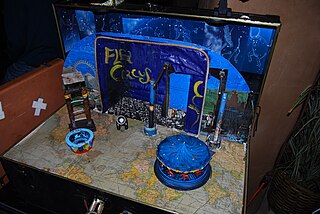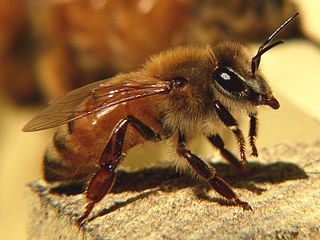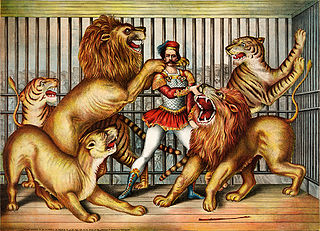 W
WAnimal training is the act of teaching animals specific responses to specific conditions or stimuli. Training may be for purposes such as companionship, detection, protection, and entertainment. The type of training an animal receives will vary depending on the training method used, and the purpose for training the animal. For example, a seeing eye dog will be trained to achieve a different goal than a wild animal in a circus.
 W
WAnimals in sport are a specific form of working animals. Many animals, at least in more commercial sports, are highly trained. Two of the most common animals in sport are horses and dogs.
 W
WElephants in captivity are elephants kept under human care in a facility such as a zoo, sanctuary, circus, or camp, usually under veterinary supervision. They can be used for educational, entertainment, or work purposes. The earliest evidence of captive elephants dates to the Indus Valley Civilization about 4,500 years ago. Since then, captive elephants have been used around the world in war, ceremony, and for manual labor and entertainment. Captive elephants have been kept in animal collections for at least 3,500 years. The first elephant arrived in North America in 1796. London Zoo, the first scientific zoo, housed elephants beginning in 1831. Before the 1980s, zoos obtained their elephants by capturing them from the wild. Increased restrictions on the capture of wild elephants and dwindling wild populations caused zoos to turn to captive breeding. The first successful captive birth in North America of an Asian elephant occurred at Oregon Zoo in 1962, while the first African elephant captive birth occurred at Knoxville Zoological Gardens in 1978. Today, most zoos obtain their elephants primarily through breeding, though occasionally zoos will obtain elephants from semi-captive work camps in Asia or rescue elephants that would otherwise be culled in Africa. Without an increase in birth rates or an influx of wild elephants, practitioners fear that captive elephant populations could become non-viable within 50 years. In 2006, 286 elephants were kept in American zoos. Nearly one in three Asian elephants lives in captivity—about 15,000 in total—mostly in work camps, temples, and ecotourism sites in the countries in which they naturally occur. The International Union for Conservation of Nature (IUCN) estimates the total population of Asian elephants in the wild is 40,000 to 50,000, and that of African elephants in the wild is 400,000 to 600,000.
 W
WCat training is the process of modifying a domestic cat's behavior for entertainment or companionship purposes. Training is commonly used to reduce unwanted or problematic behaviors in domestic cats, to enhance interactions between humans and pet cats, and to allow them to coexist comfortably. There are various methods for training cats which employ different balances between reward and punishment.
 W
WClicker training is a positive reinforcement animal training method based on a bridging stimulus in operant conditioning. The system uses conditioned reinforcers, which a trainer can deliver more quickly and more precisely than primary reinforcers such as food. The term "clicker" comes from a small metal cricket noisemaker adapted from a child's toy that the trainer uses to precisely mark the desired behavior. When training a new behavior, the clicker helps the animal to quickly identify the precise behavior that results in the treat. The technique is popular with dog trainers, but can be used for all kinds of domestic and wild animals and small children.
 W
WExecution by elephant was a common method of capital punishment in South and Southeast Asia, particularly in India, where Asian elephants were used to crush, dismember or torture captives in public executions. The animals were trained and versatile, able to kill victims immediately or to torture them slowly over a prolonged period. Most commonly employed by royalty, the elephants were used to signify both the ruler's absolute power and his ability to control wild animals.
 W
WA flea circus is a circus sideshow attraction in which fleas are attached to miniature carts and other items, and encouraged to perform circus acts within a small housing.
 W
WSniffer bees or sniffer wasps are insects in the order Hymenoptera that can be trained to perform a variety of tasks to detect substances such as explosive materials or illegal drugs, as well as some human and plant diseases. The sensitivity of the olfactory senses of bees and wasps in particular have been shown to rival the abilities of sniffer dogs, though they can only be trained to detect a single scent each.
 W
WInvisible Fence Inc. is a company that designs pet fences for cats and dogs. Manufactured and distributed by Radio System Corps, the company sells wireless and fenceless systems that revolutionized pet containment when it was first introduced in 1973. Its best known product consists of an underground wire installed by an Invisible Fence employee or franchisee around the perimeter of an area, a collar with an integrated transmitter that provides a signal to the pet when it approaches the perimeter, training provided by Invisible Fence and additional training instructions for the pet owner.
 W
WLion taming is the taming and training of lions, either for protection or for use in entertainment, such as the circus. The term often applies to the taming and display of lions and other big cats such as tigers, leopards, jaguars, black panthers, cheetahs, and cougars. People often use lion taming as a metaphor for any dangerous activity. Lion taming occurs in zoos across the world to enable the keepers to carry out medical procedures and feedings.
 W
WMarine mammal training is the training and caring for marine life such as, dolphins, killer whales, sea lions, walruses, and other marine mammals. It is also a duty of the trainer to do mental and physical exercises to keep the animal healthy and happy.
 W
WParrot training, also called parrot teaching, is the application of training techniques to modify the behavior of household companion parrots. Training is used to deal with behavior problems such as biting and screaming, to train husbandry behaviors such as allowing claw trimming without restraint or accepting a parrot harness, and to teach various tricks.
 W
WSnake charming is the practice of appearing to hypnotize a snake by playing and waving around an instrument called a pungi. A typical performance may also include handling the snakes or performing other seemingly dangerous acts, as well as other street performance staples, like juggling and sleight of hand. The practice was historically the profession of some tribesmen in India but this is no longer the case. Snake-charmer performances still happen in other Asian nations such as Pakistan. Bangladesh, Sri Lanka and south-east Asian nations like Thailand and Malaysia are also home to performers, as are the North African countries of Egypt, Morocco and Tunisia.
 W
WA tame bear, often called a dancing bear, is a wild bear captured when young, or born and bred in captivity, and used to entertain people in streets or taverns. Dancing bears were commonplace throughout Europe and Asia from the Middle Ages to the 19th century, and can still be found in the 21st century in some countries.
 W
WThe Amazing Acro-cats is a circus troupe of domestic cats and a few other small animals, founded by animal trainer Samantha Martin in Chicago, Illinois. One of the featured acts is the musical band, the Rock-Cats. The troupe, based in Griffin, Georgia, tours the United States for much of the year.
 W
WThe Ursari or Richinara are the traditionally nomadic occupational group of animal trainers among the Romani people.